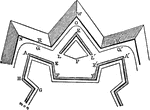Clipart tagged: ‘Rampart’

Curtain
"Curtain, in Fortification, is the portion of rampart or wall between two bastions or two gates. In…

Ramparts of Ulm
Ramparts or limes, defensive walls or fortifications constructed for defense of ancient cities or settlement…